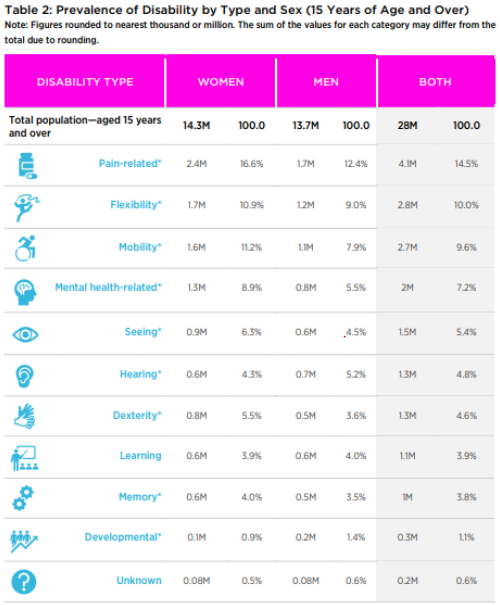Table of contents:
- What is accessibility in customer communications management?
- What is the definition of disability?
- Organizations must provide for impairment types and ability levels
- Accessibility is increasingly a regulatory requirement
- Accessibility is a commercial necessity
- Accessibility in CCM
Accessibility is both a regulatory requirement and a commercial advantage
Various regulatory deadlines are looming for organizations to ensure that their services and communications are accessible to people with disabilities. Part of the requirement for accessible communication, is that any document, web page or form that an organization shares with its customers, needs to be easy to consume by a person with disabilities.
Read on to find out more about accessibility in customer communications management, why it is relevant and what companies in the US, Canada and the UK need to do to ensure they are compliant with the relevant regulations.

What is accessibility in customer communications management?
Accessibility in CCM refers to how easily a recipient with a physical impairment or learning disability can access or consume information. Regardless of whether it is contained on an organization’s portal or web page; in an email or text; or in a document that is presented online.
According to the US definition, accessibility requires that all people, without discrimination, have access to “the full and equal enjoyment of the goods, services, facilities, privileges, advantages, or accommodations of any place of public accommodation.”
What is the definition of disability?
Countries such as the USA, Canada and the UK have slightly different definitions of disability, and it’s important to understand these, so that your organization can ensure it provides for regional requirements.
Here are the official definitions:
![]()
According to the US federal government, the term “disability” means, with respect to an individual-
- a physical or mental impairment that substantially limits one or more major life activities of such individual;
- a record of such an impairment; or
- being regarded as having such an impairment.
(Read more about this: US Department of Labor)
![]()
![]()
![]()
![]()
The Accessibility for Ontarians with Disabilities Act, 2005 (AODA) uses the same definition of “disability” as the Ontario Human Rights Code (OHRC), which includes both visible and non-visible disabilities. Under the OHRC, “disability” means,
- any degree of physical disability, infirmity, malformation or disfigurement that is caused by bodily injury, birth defect or illness and, without limiting the generality of the foregoing, includes diabetes mellitus, epilepsy, a brain injury, any degree of paralysis, amputation, lack of physical co-ordination, blindness or visual impediment, deafness or hearing impediment, muteness or speech impediment, or physical reliance on a guide dog or other animal or on a wheelchair or other remedial appliance or device,
- a condition of mental impairment or a developmental disability,
- a learning disability, or a dysfunction in one or more of the processes involved in understanding or using symbols or spoken language
- a mental disorder, or
- an injury or disability for which benefits were claimed or received under the insurance plan established under the Workplace Safety and Insurance Act, 1997;
The definition includes disabilities of different severity, visible as well as non-visible disabilities, and disabilities the effects of which may come and go.
(Taken verbatim from Accessibility Services Canada)
![]()
![]()
![]()
![]()
Under the UK Equality Act 2010, a person is considered to have a disability if they have a physical or mental impairment that has ‘substantial’ and ‘long term’ negative effects on their ability to perform normal, daily activities.
“Substantial’ is more than minor or trivial, e.g. it takes much longer than it usually would to complete a daily task like getting dressed. ‘Long-term’ means 12 months or more, e.g. a breathing condition that develops as a result of a lung infection.
(Read more on UK.gov)


Organizations must provide for impairment types and ability levels
Organizations must cater for different disabilities grouped according to visual, auditory, cognitive, and motor impairments. Furthermore, allowances must be made for a range of abilities within each.
- Visual impairments range from low or partial vision to blindness
- Auditory disabilities range from low hearing to deafness
- Motor or mobility challenges are physical impairments that result from conditions, such as cerebral palsy or muscular dystrophy
- Cognitive impairments relate to difficulty in processing information, such as dyslexia and autism
Accessibility is increasingly a regulatory requirement
Accessibility is already a legal requirement in many countries, either by specific legislation, or as part of non-discrimination law. Existing laws that prohibit discrimination based on gender or race also ban discrimination against people living with disabilities.
Here is some insight into the accessibility laws in the US, Canada and UK:
![]()
![]()
![]()
The law that governs accessibility in the U.S. is the Americans with Disabilities Act (ADA). Even though it doesn’t mention websites or communications with customers, Title III of the ADA has been interpreted by U.S. courts to apply to websites and by extension, any digital properties provided to customers.
There is actually no law for private entities in the U.S. that specifically mandates accessibility – but based on information found in Department of Justice actions, court rulings and demand letters, it’s wiser for companies to actively pursue accessibility than to risk a lawsuit.
“The ADA requires that title II entities (State and local governments) and title III entities (businesses and nonprofit organizations that serve the public) communicate effectively with people who have communication disabilities. The goal is to ensure that communication with people with these disabilities is equally effective as communication with people without disabilities.” – Source
The gist of the ADA is, if you don’t make all services accessible – this includes your website, portal, communications, documents and forms, then you’re discriminating against those with disabilities.
![]()
![]()
![]()
![]()
The Accessibility for Ontarians with Disabilities Act, or AODA, aims to identify, remove, and prevent barriers for people with disabilities. The AODA became law on June 13, 2005 and applies to all levels of government, nonprofits, and private sector businesses in Ontario that have one or more employees.
The AODA complements, but does not supersede, the requirements for accessibility and accommodation described under the Ontario Human Rights Code.
The AODA includes requirements that all organizations must meet, with deadlines specific to an organization’s type and size. The AODA allows for monetary penalties following any violation to the Act.
![]()
![]()
![]()
![]()
In the UK, the Equality Act 2010 protects individuals from unfair treatment, and this includes the requirement for website owners to anticipate the needs of people with disabilities and make ‘reasonable adjustments’ to their sites.
That means a company website, portal and mobile app must, as a minimum, meet level AA of the Web Content Accessibility Guidelines (WCAG 2.1) And all digital services and communication must be accessible via common assistive technologies – including screen magnifiers, screen readers and speech recognition tools.
There are consequences for companies that don’t meet accessibility standards — some of which include complaints being brought to industry regulators, an ombudsman, or The Equality and Human Rights Commission.
Aside from legal consequences, there is also the risk of reputational damage, should an accessibility failure be made public.
Accessibility is a commercial necessity
The motivation to achieve accessibility goes beyond just ensuring regulatory compliance. It is also about successfully achieving customer engagement through transactional or marketing communications.
When an organization’s digital assets are not accessible, the information they share is not reaching a significant portion of their customer base.
“Currently around 10% of the world’s population, or roughly 650 million people, live with a disability. In most of the OECD countries, females have higher rates of disability than males”.
– Disabled World
Here are the population statistics for people living with a disability in the US, Canada and UK:
![]()
![]()
According to the CDC, 61 million adults in the United States live with a disability, that means 26% or 1 in 4 adults have some type of disability.
Here is another level of detail on the percentage of US adults with functional disability types:
- 13.7 percent of people with a disability have a mobility disability with serious difficulty walking or climbing stairs.
- 10.8 percent of people with a disability have a cognition disability with serious difficulty concentrating, remembering, or making decisions.
- 6.8 percent of people with a disability have an independent living disability with difficulty doing errands alone.
- 5.9 percent of people with a disability are deaf or have serious difficulty hearing.
- 4.6 percent of people with a disability have a vision disability with blindness or serious difficulty seeing, even when wearing glasses.
- 3.6 percent of people with a disability have a self-care disability with difficulty dressing or bathing. Source
There are commercial impacts for an organization that fails to cater for disability requirements – in short, this means customers affected will simply move their business elsewhere.
![]()
![]()
![]()
![]()
According to a January 2020 study by Skills Next, one in five Canadians aged 15 or older-about 6.2 million people-have one or more disabilities. Rates of disability increase with age: 13 percent of Canadians aged 15 to 24 have at least one disability, compared with 38 percent of those aged 65 and older.
Today, 15.5% of Ontario’s population have a disability and this number will continue to grow as the population ages.
An interesting note: according to the Skills Next paper, disability was historically characterized in Canada as a “structural or functional deficit associated with a person. More recent understandings of the disablement process draw on a social and socio-medical approach, where a health deficit or impairment is a necessary but not sufficient condition for disability. These definitions regard as critical the social, attitudinal, and built environments that “create” disability by imposing barriers to participation for persons with abilities outside the range defined as “normal.” In this framing, disability is a social construction rather than a characteristic of an individual.” Source
![]()
![]()
![]()
![]()
According to a 2018/2019 Family Resources Study, an estimated 19% of working-age adults in the UK live with a disability, as does 45% of the pension age population.


There is a commercial advantage for organizations that meet accessibility guidelines for services and communications with customers. By doing so, compliant organizations are reaching their full target audience.
Organizations must provide for impairment types and ability levels
Organizations must cater for different disabilities grouped according to visual, auditory, cognitive, and motor impairments. Furthermore, allowances must be made for a range of abilities within each.
- Visual impairments range from low or partial vision to blindness
- Auditory disabilities range from low hearing to deafness
- Motor or mobility challenges are physical impairments that result from conditions, such as cerebral palsy or muscular dystrophy
- Cognitive impairments relate to difficulty in processing information, such as dyslexia and autism
Accessibility in CCM
In general, accessibility requirements extend to any service or communication that is provided by an organization to its customers. This includes physical service centers, branches, shops, malls and so on.
When it comes to Customer Communications Management, organizations must strive for accessibility in any communications that are physically delivered or mailed to customers – such as printed statements, bills, collections notices, payment notifications, etc.
In addition, all digital properties such as documents, communications via email or text, as well as websites and mobile apps (which in the US are considered “places of public accommodation”) must be accessibility compliant.
When it comes to Customer Communications Management, transactional communications and documents, such as financial statements, bills, tax documents and others, that need to be produced on time and at scale for millions of recipients, present one of the key challenges when it comes to ensuring accessible communications.
To ensure such CCM solutions are compliant, organizations need a technology partner capable of providing a variety of compliant formats, reliably and in a cost-effective way.


Download Doxim’s CCM Accessibility Feature Sheet
Doxim CCM solutions for accessibility compliant communications
To achieve the required levels of accessibility in customer communications management, organizations need a technology partner with a CCM platform capable of providing a variety of compliant communication formats, reliably and in a cost-effective way.
Let Doxim’s experienced CCM team assist in getting your emails, portal pages, landing pages and customer documents fully compliant with accessibility standards.
We follow a simple process:
- Audit all customer communication to determine accessibility
- Identify the most important communications and redesign for accessibility
- Map the balance of communications onto an accessibility compliance plan with timelines
Doxim offers an all-in-one partnership to help clients create accessible customer communications. Our team understands accessibility requirements, can assist with relevant advice and expertise and our platform produces accessible communications on time and at scale for millions of recipients.








